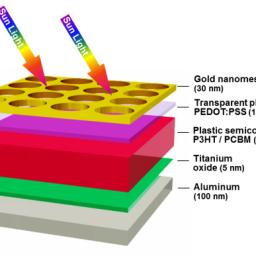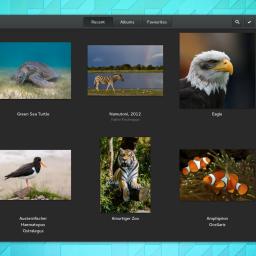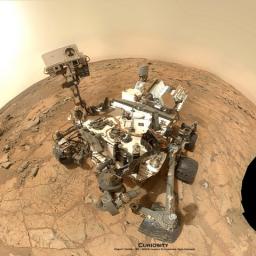What's new in robotics? Depends where you are.
Scientists at Harvard are putting their time and energy into the newish field of soft-robotics, a field that uses elastomer - a type of polymer similar to rubber - to perform behaviors such as grasping a human hand or crawling across the ground. Eventually, researchers say that soft robots may be instrumental in things such as physical therapy, minimally invasive surgery, and search-and-rescue operations. By using soft robotics, engineers have created projects like a pneumatic glove for rehabilitating hand movement, a cardiac simulator that mimics the precise movements of a human heart, and a device for thumb rehabilitation.
In Japan, meanwhile, scientists are putting a happier spin on swarm robots - small robots that can communicate and interact to achieve common goals - by
rolling out cheerleader robots that use swarm technology to animate and entertain.
The Murata Cheerleading robots ... look like dolls, have glowing eyes and balance on steel balls. Unveiled Thursday in Tokyo by components maker Murata Manufacturing, each bot looks like a cartoonish girl sporting a red skirt and short black hair. A series of rollers under the skirt keep the robot balanced on a ball or rotate it in a particular direction to move around. Under the afro, meanwhile, nestles an infrared sensor and ultrasonic microphones that help the robot detect objects nearby. Three gyro sensors control motion from front to back, side to side and in rotation. A wireless network is used to control a group of 10 cheerleader robots. They can perform precisely synchronized dance routines, moving into formations such as a heart while spinning on their balls.
It's all very kawaii, and of course intended to generate attention among Japanese audiences and visitors to trade shows. "We designed the cheerleader robots to cheer people up and make them smile," said Murata spokesman Koichi Yoshikawa. "Their features can be summed up as '3S': stability, synchronization and sensing and communication."
Now, what could we do if we combined those two technologies?

PostgreSQL, the much-loved opensource relational database, is
ramping up its nosql game with a new developer kit that gives access to NoSQL features that beat MongoDB in benchmarks.
The PostgreSQL Project, which EnterpriseDB supports, added NoSQL-style JSON processing features back in 2012. Now, the company is encouraging further work around that feature set by providing a developer kit to make it easier for programmers to leverage PostgreSQL's JSON functions and build applications around them. ... The PGXDK (Postgres Extended Datatype Developer Kit) is designed to allow developers "to use Postgres for the kinds of applications that until recently required a specialized NoSQL-only solution," as EnterpriseDB describes it. A sample application is also included to make it easier for developers to get a leg up on working with the product. The whole package will be made available through AWS as a machine image (PostgreSQL has long been a staple Amazon offering).
Vibhar Kumar has published a set of benchmarks here that show PostgreSQL eating MongoDB's lunch when measured in use of diskspace, bulk loading, and INSERTs.

Considering how ubiquitous LEDs are becoming in our gadgets, phones, and even ambient lighting, it's good to look for efficiencies and process improvements in their manufacture. Princeton University researchers have developed a new method to increase the brightness, efficiency and clarity of LEDs, which may lead to big changes in this technology.
Although they are known for their efficiency, only about 38 percent of light generated inside an LED actually escapes, due to hitting the envelope of the LED at an angle of incidence greater than the critical angle. The trapped light (called total internal reflections) also heats the LED, which greatly reduces its lifespan.
The solution presented by Chou's team at Princeton University is the invention of a nanotechnology structure called PlaCSH (plasmonic cavity with subwavelength hole-array). The researchers reported that PlaCSH increased the efficiency of light extraction to 60 percent. Chou and his team are now conducting experiments to demonstrate PLaCSH in red and blue organic LEDs, in addition the green LEDs used in the current experiments.
This reported breakthrough appears
strikingly similar to one from the University of Glasgow in 2007, similarly reporting the use of cost-effective nanotechnology processes to greatly improve efficiency of LEDs.
PlaCSH technology was first announced two years ago,
reported to offer a 175 percent efficiency improvement to photo-voltaic solar cells, additionally reducing the thickness of the silicon used in traditional solar panels by a thousand-fold, while also being cost-effective to manufacture.
Upgrade now, if you can.
A bug discovered in the widely used Bash command interpreter poses a critical security risk to Unix and Linux systems - and, thanks to their ubiquity, the internet at large.
From the Register:
It lands countless websites, servers, PCs, OS X Macs, various home routers, and more, in danger of hijacking by hackers.
The vulnerability is present in Bash up to and including version 4.3, and was discovered by Stephane Chazelas. It puts Apache web servers, in particular, at risk of compromise: CGI scripts that use or invoke Bash in any way - including any child processes spawned by the scripts - are vulnerable to remote-code injection. OpenSSH and some DHCP clients are also affected on machines that use Bash.
Now is also a good time to wipe your servers and reinstall Minix or Plan9 as a precaution. ;)

Blackberry has released a phone that either pushes the boundary of phone design in useful ways, or proposes a new and unusable form factor, according to your personal pre-inclination.
The Register reviews it and calls it crazy, but full of great ideas. It's square, for one, a radical departure from the candy-bar form factor so prevalent in modern smartphones. It's also sporting improvements to its QNX-based new OS, a great screen, and reportedly a 30 hour battery life. It runs Android apps natively, with no apparent lag or problem. Lastly, the keyboard doubles as a trackpad - something you'll either love or hate.
The Guardian takes a look at it here, and offers some other insights. There are some lovely pictures at The Verge, who conclude, by they way that they don't like it.
[Ed. note: Me, I want one.]
 Gnome 3.14 has been released
Gnome 3.14 has been released, six months after the last version. Sporting "new features and bug fixes, and 28859 changes by approximately 871 contributors," install this new version to enjoy:
- a new weather panel
- support for captive portal (wifi hot spot authentication)
- multi-touch features
- household network connection sharing
- support for online picture-sharing sites
- improvements to the evince PDF reader
... and more.
[Ed. note.] I've never seen release notes that look they were put together by a website designer and marketing agency. What happened to a bunch of bullet points in ASCII posted to Usenet? These release notes are "gorgeous."

As Satya Nadella's axe continues to fall at Microsoft,
the corporation's Silicon Valley research lab has been the next to succumb to the severe round of staff reductions ongoing this year.
In a move that appears to reflect a new level of urgency to Nadella's consolidation plans, the Redmond giant has closed one of its flagship engineering facilities and released dozens of world-class scientists into the job market - and the welcoming arms of its competitors. The Mountain View site reportedly employed a team of 75 that focused exploring new applications for distributed computing - the fundamental concept behind the cloud - in areas such as natural language search, data privacy and network security.
But although the lab itself is no longer operational, Microsoft is still clinging to its Silicon Valley research investment. Projects that were ongoing at the time of the termination have been transferred to other research facilitates along with key members of the original team, which indicates that business will continue more or less as usual at those sites for the foreseeable future.
While the cuts were met with stockholder approval, there's speculation Nadella's staff reductions are a strategy of short term gains that will jeopardize the corporation's long term prospects.

In a move to compete on the mobility front,
Red Hat Linux is acquiring FeedHenry for about US$82 million. The enterprise mobile application platform provider essentially makes it possible for Red Hat to support mobile application development in public and private environments.
From
ConvergedDigest:
FeedHenry, which is based in Waterford, Ireland, helps enterprises to accelerate mobile app backend integration via private clouds, public clouds, and on-premises systems with connectors and plug-ins to common enterprise systems such as salesforce.com, SAP, Oracle, etc. The FeedHenry platform offers developers the flexibility to create native (Android, iOS, Windows Phone and Blackberry), hybrid, HTML5 or web apps. The platform supports a wide variety of popular toolkits including native SDKs, hybrid Apache Cordova, HTML5 and Titanium, as well as frameworks such as Xamarin, Sencha Touch, and other JavaScript frameworks.
FeedHenry was founded in 2010 as a spin out from the Telecommunications Software and Systems Group at the Waterford Institute of Technology.
Seems like good news for mobile platforms based on FOSS technologies. Or is this just RedHat trying to stay relevant in a world where operating systems matter less than web services and mobile access?

At 70 percent complete, and slated to be open and operating November of 2015,
the Carlsbad Desalination Project is predicted to be, at 50-million gallons per day, the largest and most energy-efficient seawater desalination plant in the Western Hemisphere. And it will supply enough water to meet about 7 percent of San Diego county's water needs.
The water authority has pledged to buy the desalinated water at $2,014 to $2,257 per acre-foot. About twice the cost of traditional water supplies, but about half that of desalination plants just 10 years ago. An acre-foot is enough to supply two homes for a year. During the first full year of production - in 2016 - the desalinated water will add about $5.14 per month to the typical household's water bill, according to the water authority.
"This source, since it's not dependent on rainfall and snow melt, is the (region's) first drought-proof source of water."
But they're not going all-in with desalination. San Diego city's plan to purify wastewater to drinking-water standards is the next major item on their agenda. The city envisions constructing a water-purification plant that can generate 83 million gallons of drinking water per day by 2035. The purification plant could also help eliminate the need for $1.8 billion in overdue upgrades to the Point Loma Wastewater Treatment Plant by reducing the amount of wastewater that must be piped to sea.

In the past decade, probes orbiting Mars and telescopes on Earth have detected what appeared to be plumes of methane gas from the Red Planet. The presence of colorless, odorless, flammable methane on Mars, the simplest organic molecule, helped revive the possibility of life once existing, or even currently living, just below the planet's surface. Scientists have suspected that methane stays stable in the Martian atmosphere for only about 300 years, so whatever is generating this gas did so recently.
A large-scale non-biological source of methane production on Mars might have been an even more exciting result. A renewable process humans might be able to adapt for use on Earth to meet our energy needs. But Curiosity has revealed no trace of methane on the Martian surface.
"Based on earlier observations, we were expecting to land on Mars and measure background levels of methane of at least several parts per billion, but saw nothing," Webster told Space.com.
"It's a mystery surrounded by an enigma here," said imaging physicist Jan-Peter Muller.
http://www.nbcnews.com/science/space/mars-mystery-deepens-curiosity-finds-no-sign-methane-f4B11202946






